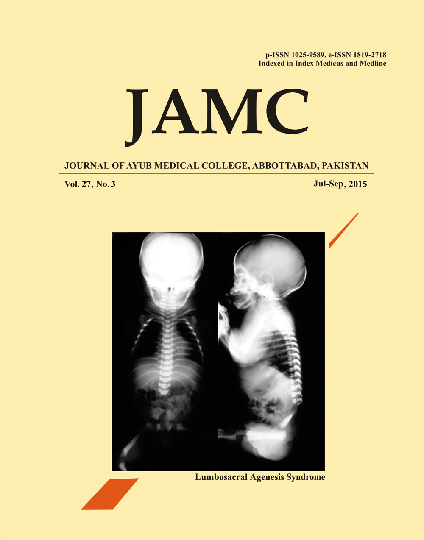HYPERCHOLESTEROLEMIA IN PATIENTS OF ISCHEMIC STROKE
Abstract
Background: Stroke is a common neurological disease that results in significant mortality and morbidity globally. Several risk factors have been identified for stroke among which hyperlipidaemia is one of the modifiable risk factors. Recent clinical trials have showna reduction in ischemic stroke for patients takinglipid lowering medications. Therefore, the aim of this studywas to find out the frequency of hypercholesterolemia in patients of ischemic stroke in Hazara region. Methods: This cross sectional study was carried out in the Medical Department of Ayub Teaching Hospital, Abbottabad. Ninety patients of stroke confirmed as ischemic by CT scan brain were enrolled in the study after informed consent. The frequency of hypercholesterolemia in patients was recorded. Results: There were 55 (61.1%) males. The mean age of patients was 64.4±11.5 years. The mean serum cholesterol in all patients was 4.16±1.1 mmol/l. The mean serum cholesterol of male patients was 4.3±1.2 mmol/l and 4.0±10.9 mmol/l in the case of females. Conclusions: Hypercholesterolemia could not be established as a major risk factor for stroke in our setup through this study that allude to the fact that other risk factors might be contributing more to the incidence of cerebrovascular accident in our population.References
Brass LM. Strategies for primary and secondary stroke prevention. Clin Cardiol 2006;29:II21–7.
Iqlseder B, Moroder T, Staffen W, Laderner G. High Prevalence and under treatment of hypercholesterolemia in participants in a public stroke prevention programme in Austria. Clin Drug Investig 2005;25:709–17.
Sulehria B, Asrar A, Qureshi I. Comparison of lipid profile in thrombotic and haemorrhagic stroke patients. Ann King Edward Med Coll 2007;11:482-4.
Laloux P, Galanti L, Jamort J. Lipids in ischemic stroke. Acta Neurol Belq 2004;104:13–9.
Iqbal F, Hussain S, Hassan M. Hypertension, diabetes mellitus and hypercholesterolemia as risk factors for stroke. Pakistan J Med Res 2003;42:17–22.
Lipovetskii BM. [About dyslipidemic states characteristic for various forms of ischemic heart disease and cerebrovascular damage]. Kardiologii 2007;47:8–11.
Almani SA, Shaikh M, Shaikh MA, Shaikh K, Rahopoto Q, Baloch G, et al. Stroke: Frequency of risk factors in patients admitted in Liaquat University Hospital Hyderabad/Jamshoro. J Liaquat Uni Med Health Sci 2008;4:151–6.
Khan NI, Naz L, Mushtaq S, Rukh L, Ali S, Hussain Z. Pak Ischemic stroke: prevalence of modifiable risk factors in male and female patients in Pakistan. Pak J Pharm Sci 2009; 22:66–7.
Khan FY. Risk factors of young ischemic stroke in Qatar. Clin Neurol Neurosurg 2007;109:770–3.
Rathore JA, Kango ZA, Nazir M, Mehraj A. Risk factors for stroke: a prospective hospital based study. J Ayub Med Coll Abbottabad. 2013;25(1-2):19–22.
Zhang X, Patel A, Horibe H, Wu Z, Barzi F, Rodgers A, et al. Cholesterol, coronary heart disease, and stroke in the Asia Pacific region. Int J Epidemiol 2003;32:563–72.
Tirschwell DL, Smith NL, Heckbert SR, Lemaitre RN, Longstreth WT Jr, Psaty BT. Association of cholesterol with stroke risk varies in stroke subtypes and patient subgroups. Neurology 2004;63:1868–75.
Published
Issue
Section
License
Journal of Ayub Medical College, Abbottabad is an OPEN ACCESS JOURNAL which means that all content is FREELY available without charge to all users whether registered with the journal or not. The work published by J Ayub Med Coll Abbottabad is licensed and distributed under the creative commons License CC BY ND Attribution-NoDerivs. Material printed in this journal is OPEN to access, and are FREE for use in academic and research work with proper citation. J Ayub Med Coll Abbottabad accepts only original material for publication with the understanding that except for abstracts, no part of the data has been published or will be submitted for publication elsewhere before appearing in J Ayub Med Coll Abbottabad. The Editorial Board of J Ayub Med Coll Abbottabad makes every effort to ensure the accuracy and authenticity of material printed in J Ayub Med Coll Abbottabad. However, conclusions and statements expressed are views of the authors and do not reflect the opinion/policy of J Ayub Med Coll Abbottabad or the Editorial Board.
USERS are allowed to read, download, copy, distribute, print, search, or link to the full texts of the articles, or use them for any other lawful purpose, without asking prior permission from the publisher or the author. This is in accordance with the BOAI definition of open access.
AUTHORS retain the rights of free downloading/unlimited e-print of full text and sharing/disseminating the article without any restriction, by any means including twitter, scholarly collaboration networks such as ResearchGate, Academia.eu, and social media sites such as Twitter, LinkedIn, Google Scholar and any other professional or academic networking site.









